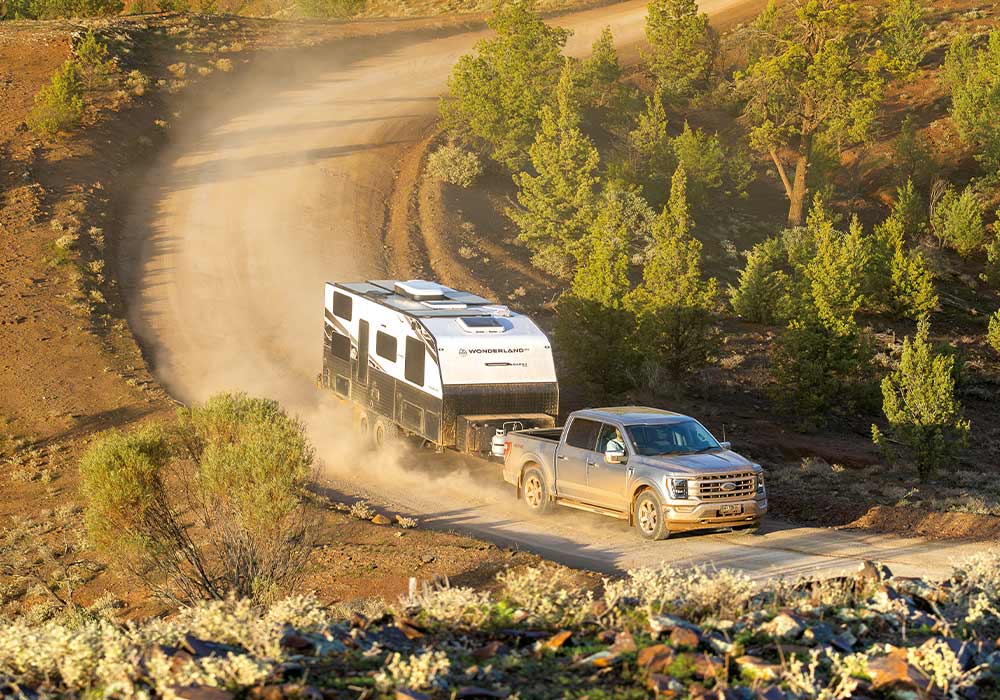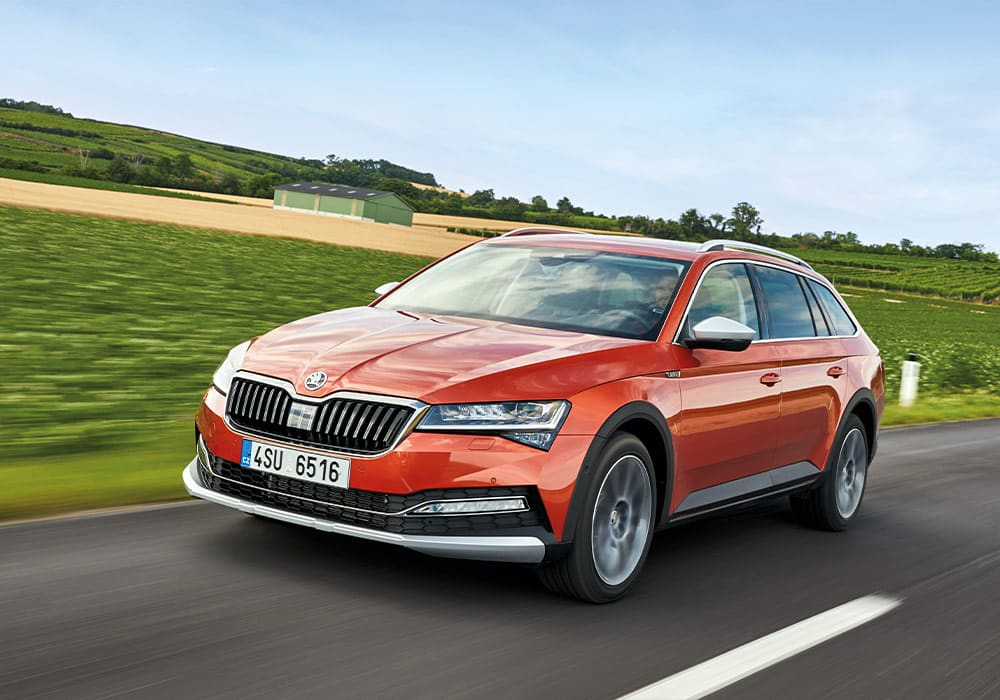We get it: you’re reading this magazine because you love camping and caravaning – or are keen to experience it at the very least. But have you thought about what you’re going to tow your caravan with? Is your current steed up to scratch? Will you need a new vehicle? Motoring writer Cameron Officer shares his insights and some things to consider, both before you go shopping and once you’ve got your holiday-home-on-wheels hitched up and ready to roll.
Less stress, more comfort, and always enough power for the job – these might be the key ingredients to picking the perfect tow vehicle. But unless you’re lucky enough to have a carpeted and air-conditioned six-bay garage with one spot reserved solely for what you tow your toys with, you’ll also want something that’s easy to handle and ticks enough boxes even when it doesn’t have something on the tow ball.
Taking a belt-and-braces approach might seem like the best idea, but while that double cab ute will pull your 24-footer without any dramas, is it really going to be the most practical thing to fetch groceries in? Similarly, you might love the look of that stealthy electric vehicle, but what is its projected range going to be like with even a modestly sized caravan on the rear?
Here are a few things to consider when choosing a good towing vehicle.
Towing capacity
Typically found in your vehicle’s manual or on the manufacturer’s website, this is probably the first place to start. Will your vehicle of choice be able to comfortably tow your caravan? Make sure the vehicle’s towing capacity exceeds the weight of your fully loaded caravan. Overloading a vehicle can lead to poor handling and increased wear on the engine and brakes. It’s logical but worth spelling out: the bigger the caravan, the bigger the tow vehicle you will need. A rough rule of thumb is that your caravan’s weight should not exceed 85% of your vehicle’s kerb weight, especially if you’re new to towing.
Engine power and torque
While horsepower is essential, torque is the key factor for towing. Torque represents the vehicle’s pulling power, which is crucial when towing heavy loads. Diesel engines generally offer better torque at lower RPMs, making them a popular choice for towing. If you prefer the performance and feel of a petrol engine, look for one with strong low-end torque for better pulling power and fuel efficiency when towing.
Stability and suspension
A vehicle’s suspension system needs to be robust to cope with the extra weight of a caravan. Look for vehicles with reinforced or adaptive suspension that can self-level under load. Stability is also a key consideration. Vehicles equipped with towing-specific features, such as Trailer Sway Control, in addition to their Electronic Stability Program (ESP), are designed to prevent dangerous snaking or swaying, improving safety.

Four-wheel drive (4WD) or all-wheel drive (AWD)
For those planning to tow in rough terrain, or simply when that South Island summer tour turns into a sodden ‘weather event’-themed one, four-wheel drive (4WD) or all-wheel drive (AWD) vehicles offer better traction and control. These systems distribute power more evenly to the wheels, which can help when towing up hills or through slippery environments.
Fuel economy
Now, this is a tough one because towing can dramatically increase fuel consumption, and no manufacturer is ever going to give you an accurate steer in the brochure material on how much more petrol or diesel you’ll be using. Generally, diesel vehicles tend to be more fuel-efficient than petrol when under load across longer distances. Modern hybrids and electric vehicles are beginning to offer towing capabilities, but as you’d expect, their range can be limited by towing heavy loads.

Comfort and interior features
Don’t overlook comfort, especially on long journeys. Vehicles with supportive seats, and Advanced Driver Assistance Systems (ADAS), such as Blind Spot Detection and Lane Keep Assist, can take the stress out of towing. When you get to your destination camping spot – or even when you’re parking the caravan up at home again after some enjoyable time on the road – useful features like rear-view cameras with reversing guidance lines and parking sensors can make the ‘garage gear’ manoeuvring much easier, too. Some larger vehicles even have rear-view cameras that give the driver a top-down view of the tow ball specifically.
A word on tow bars
If you have to get a tow bar fitted to your vehicle, there are a few things you’ll want to keep in mind. Make sure the tow bar will be compatible with your vehicle based on its listed towing capacity. Ask the supplier about installation requirements before purchasing, too: some towbars may require drilling holes into the chassis of your car, but this would be in accordance with the manufacturer’s guidelines. As long as the tow bar being fitted is fully type-approved, this won’t compromise the vehicle in any way. Any larger tow bar supplier and fitter will be able to ensure you get the right ‘bar for your car.
Towing vehicles to consider
Exterior looks, interior comfort, long-haul frugality, blatant badge favouritism. There are a multitude of motivations for purchasing a certain vehicle for a certain task, be it business or pleasure. But when it comes to towing the toys, plenty of grunt and a comfortable interior for the open road are two distinct throughlines.
Even then, there are loads of options that will appeal to specific audiences based on both the person behind the wheel as well as what’s attached to the tow ball. Here, we’ve collected five likely tow vehicles that all bring something a little different to the game.
RAM 1500 Laramie Sport
The fifth-wheeler option

If American-style trucks n’ towing is your bag, then you can’t go past the big RAM 1500. Boasting a gutsy 556Nm of torque and with the option of a heavy-duty towbar that takes its maximum braked tow rating up to 4500kg, this thing is absolutely built to haul. When you’ve got as spacious a load bed as the RAM 1500 offers at your disposal (1712mm long, 1295mm between wheelhouses), a fifth-wheeler set-up seems like the way to go. That big 5.6-litre Hemi V8 under the RAM’s broad bonnet will barely notice a thing.
Price: $154,990 (plus ORCs) Engine: 5.6L V8
Power: 291kW Torque: 556Nm
Braked towing capacity: 4.5T (with heavy-duty towbar pack)
Volskwagen Amarok Pan Americana
The double cab ute option

In the intro, we mentioned ‘blatant badge favouritism’ as one of the chief motivations for buying a particular new vehicle. Perhaps nowhere more so than in the always-busy ute market is that the case. You like what you like. Degrees of comfort and convenience tech aside, most of the mainstream utes that duke it out at the top of the sales charts all do pretty much the same thing. We could have had a handful of different nameplates represent the good old double cab ute option here, but we plumbed for the Volkswagen Amarok. It’s one of the more recently released models, is gutsy, dependable, has all the shiny stuff where you need it and plenty of safety specifications, too. And in tasty Pan Americana trim, it looks great straight off the showroom floor without having to add another $30k worth of accessories to it.
Price: $95,000 (plus ORCs) Engine: 3L V6 turbo diesel
Power: 184kW Torque: 600Nm
Braked towing capacity: 3.5T
GWM Tank 300 Lux Hybrid
The left-field option

Land Rover Defender junior? Suzuki Jimny on steroids? The Tank nameplate certainly is appropriate for GWM’s rugged-looking SUV. If you want G-Wagon-style muscle for less than half the price, then this recent arrival onto the Kiwi market will be worth a look. Available in bright colours, with a comfort-focused interior that does a good impression of a Euro SUV, and with plenty of tech and toys onboard – including proper rock crawling 4×4 capability – the Tank 300 has arrived with a ‘more is more’ approach. And because it has a hybrid powertrain, combined figures for peak power and torque for towing impress as well.
Price: $53,990 (plus ORCs) Engine: 2L turbo petrol hybrid
Power: 255kW Torque: 648Nm
Braked towing capacity: 2.5T
Škoda Superb Scout 4×4
The wagon option

Station wagons used to be a common feature of the Kiwi landscape, but the rise of SUVs has seen this once-popular body style kicked to the edges of the car park over the last 20-odd years. But hey, not everyone wants a high-riding SUV, and this particular wagon is like the Swiss (well okay, Czech) army knife of its kind. Škoda’s Superb is already an impressively spacious thing: in wagon – or Combi, to use Škoda-speak – form, it’s even more cavernous, making it a truly useful recreational vehicle. With the rear bench in place, the boot gives you 660 litres to fill, and because the wagon comes in Scout trim, that gives you four-wheel drive as well. The Superb Scout 4×4 is practicality personified.
Price: $73,990 (plus ORCs) Engine: 2L turbo petrol
Power: 206kW Torque: 400Nm
Braked towing capacity: 2.2T
MG HS Essence
The value-for-money option

MG really has pulled one out of the bag with the all-new-from-the-ground-up HS mid-size SUV. A huge departure from the previous generation HS (which, despite having only been around for six years was starting to look and feel very dated), the new model packs an incredible amount of kit, even from the entry-level option. In top Essence trim, you get all the bells and proverbials, and it still only costs $43,000. Chuck in the 10-year – yes, 10-year – standard warranty and the comfy, roomy, and rather fetching-looking HS is a mid-size caravan tower you’ll find hard to walk past.
Price: $42,990 (plus ORCs) Engine: 1.4L turbo petrol
Power: 125kW Torque: 275Nm
Braked towing capacity: 1.5T
Ford Everest Sport
The ute-with-a-boot option

In effectively being a Ford Ranger dressed in an SUV body shell, the popular Everest delivers an all-things-to-many towing solution. Especially in Sport trim, with blacked-out 20” alloy wheels and a few other fancy additions, the Everest looks great and is as big on the inside as it looks from the outside. Totally built for towing things, the Everest arrives with a towbar as part of its standard specification list and has a fancy 360-degree surround-view camera, meaning you’ve got eyes on pretty much every angle of the spot you’re reversing your caravan into. Again, because the Ranger is one of the nicest riding utes on the market, so it goes with the Everest. Oh, and did we mention it’s a seven-seater too?
Price: $79,990 (plus ORCs) Engine: 2L turbo diesel
Power: 154kW Torque: 500Nm
Braked towing capacity: 3.5T






